The market square (where we purchased
the yummy strawbs) is dominated by the old town hall (Rathaus, left)
and other buildings with great roof lines. There are also many
entrances into passageways - some of which are self-contained
malls and some just beautiful lanes to other streets. The most famous
is the Mädlerpassage, where one of the scenes in Faust is set and
where there is now a statue of Faust with Mephisto (the devil). The
market square bustles with energy and is clearly the heart of the
town. Elyse enjoyed wandering around and finding the hidden
spots. The building on the right (with the elephants above the
entrance) is where we had dinner one night. A beautiful spot.
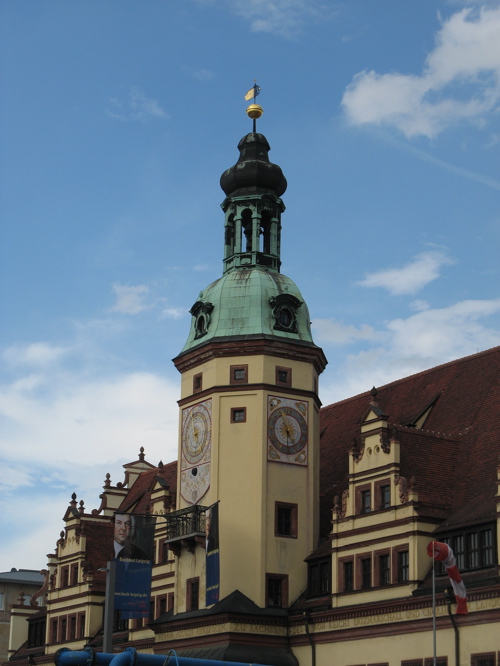
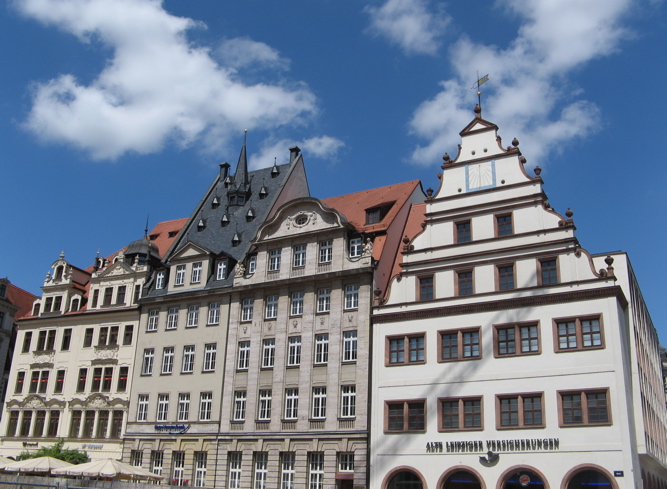
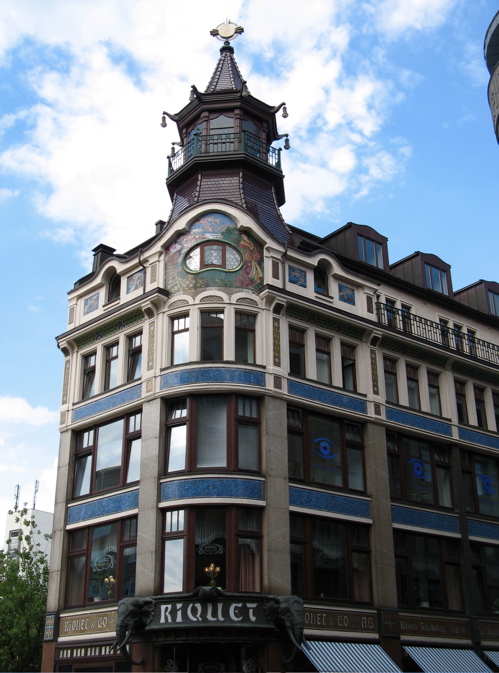
That evening, we joined the other
lecturers, event organizers and physics students at a beer garden
near the Institute. We had delicious beer and food and found ourselves stuck
(luckily under large umbrellas) in a huge thunderstorm. We drank
some more beer thinking it would pass, but finally gave up and took a
taxi back to the hotel. We got drenched from the rain just during
the run from the taxi to the hotel's front door!
Gerald had another morning of lectures to give, so Elyse went off exploring again. Most of the museums, etc. don't open until 10 am, so she explored the neighborhood (where she noticed the effects of East German times) and walked through a huge park that is on the edge of town. Her first stop that morning was the "Museum in the Round Corner", once the headquarters of the city's secret police (or Stasi) and now a museum describing their techniques and impact. Luckily there was a guide in English for her to read, but even without it once could sense how deeply the Stasi's power permeated society. The exhibits included costumes (e.g., wigs, fake noses, etc.) and surveillance devices (e.g., button-microphones, secret cameras, handbag-recorders) that could have been something out of a bad spy movie if one didn't realize that they were all real. There were explanations on how letters were read, copied, and often confiscated; on how even people's scents were stored (below, left) in case dogs needed to track them down later; on the cameras placed everywhere to keep track of people's movements and meetings; and on how the millions of documents were filed, stored and - when the end was imminent - attempted to be destroyed (below, right). There were exhibits of how the government got and kept its power using warnings about the presence of enemies amongst "regular" people and of those enemies' plans to undermine the fabric and values of society. There were stories of lives ruined by one negative statement and of the constant fear of a misstep that permeated society. But it was the photographs of the thousands of people with candles in front of the St. Nicholas Church and in the streets, despite the threatening presence of the police and the knowledge that people were risking everything by being there, that really "got" to Elyse. It must have taken tremendous courage to stand up - peacefully - to such power, to reject the idea of an omnipresent enemy, and to demand basic rights of protest, freedom of thought and of expression. A potent reminder of police-powers going overboard in the name of "national security".
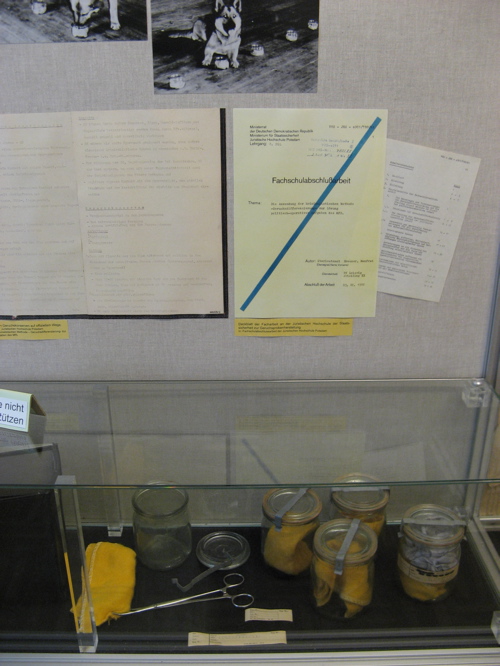
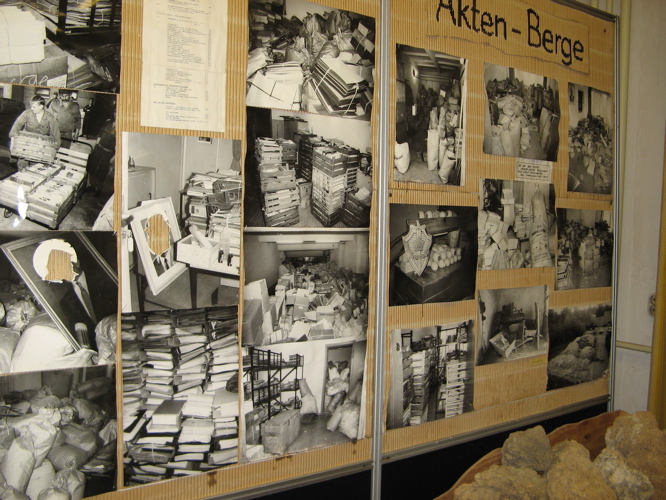
Elyse needed something a bit more "upbeat" to offset that visit and she
decided to visit the Museum of Fine Arts on her way back into the
center of town. It is housed in a bright, new building and had a
good collection of paintings by the "old masters" and by German artists
which she enjoyed seeing. But her heart wasn't in it - it was a
beautiful day and she felt like being outside and exploring the streets
of Leipzig. She also knew that her rendezvous with Gerald
scheduled for mid-afternoon at the St. Thomas Church to hear the choir (in case you
forgot, we really liked the choir's performance),
so she went through the exhibits fairly quickly.
We were lucky enough to be in Leipzig at the end of the annual Bach Music Festival. We had an extra bit of luck being there on the night of a special concert in honor of conductor Kurt Masur's (below, left) 80th birthday. [Masur had been conductor of the Gewandhaus Orchestra in Leipzig (where the concert was held) for almost 30 years, along with having been conductor for the London and New York Philharmonic Orchestras. Apparently he had also been involved in protests against the East German government. In any event, although he was born in what is now Poland, he has clearly been adopted by the city of Leipzig.] We knew we wouldn't be able to get tickets (never mind that the cheapest tickets probably cost about 200 Euros / $350), but they were broadcasting the concert on a big screen in the Augustusplatz outside the concert hall, so we got there early and found good seats right by the fountain outside the hall. We could hear the applause as famous folks entered (including special guests Kofi Annan and his wife) and see the dressed-up folks enter on the red carpet while we sat in our jeans outside. After a brief rain spell, it turned into a beautiful evening and eventually the plaza was filled with thousands of people (below, center) enjoying the music and conversations on the stage. Harald Schmidt was the moderator/MC and he was (apparently) very funny, but also clearly respected the ability of Masur and of the orchestra. The concert itself was incredible and it included a performance of Ann-Sophie Mutter (below, right) on the violin (apparently she had been mentored by Masur and they have been close friends for a long time) that was absolutely fantastic. It was actually better than being inside in some respects, especially with the close-up shots on the big screen of the musicians and Masur conducting. There was a fair bit of reminiscing (that we only partially understood) and we left about 2 1/2 hours into it to get a late dinner. The concert was still going on when we walked by on our way back to the hotel. We stopped to hear a little more music before moving on - what a special treat to end our visit.
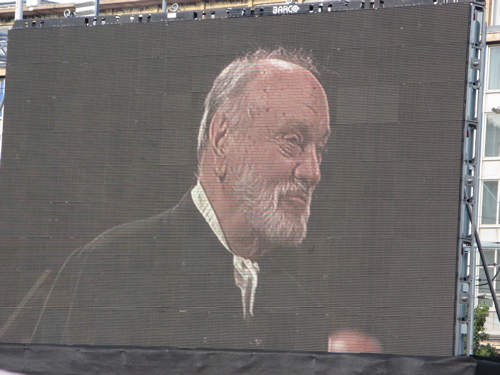
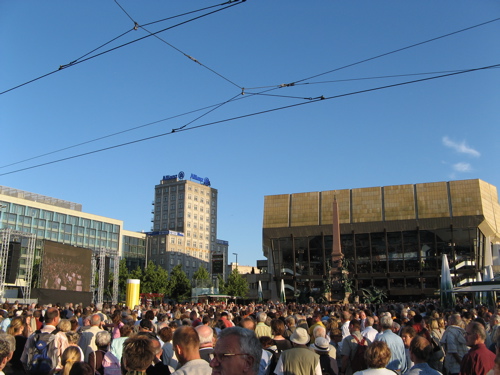
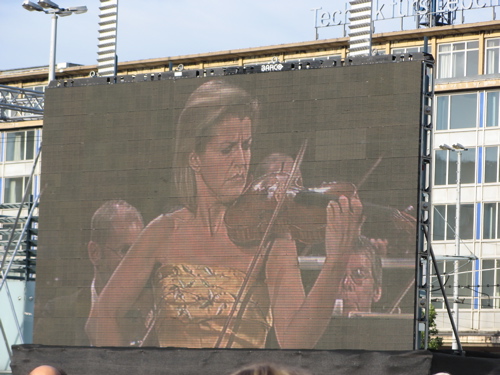
We first came upon the gardens at Zwinger - Baroque "pleasure grounds" created in the early 1700's. They are massive, ornate and beautiful in their overdone way. The fountains were going, the gilded towers were shimmering in the sun and there was a perfect sky to offset it all. We walked along the walls up top first and then headed into the courtyards below. As you can see, they didn't skimp on their gardens!
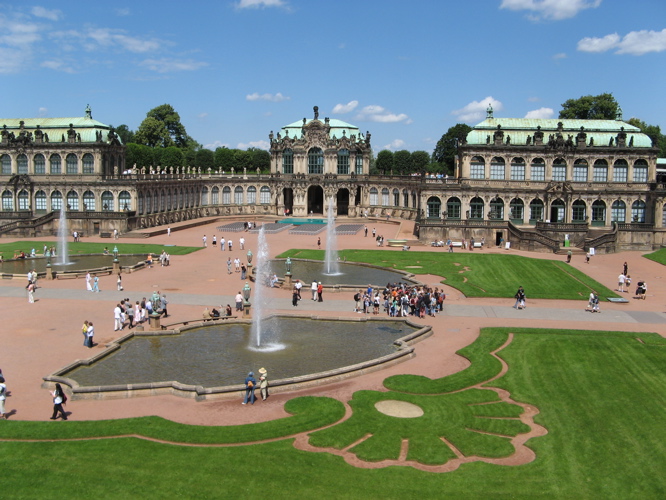
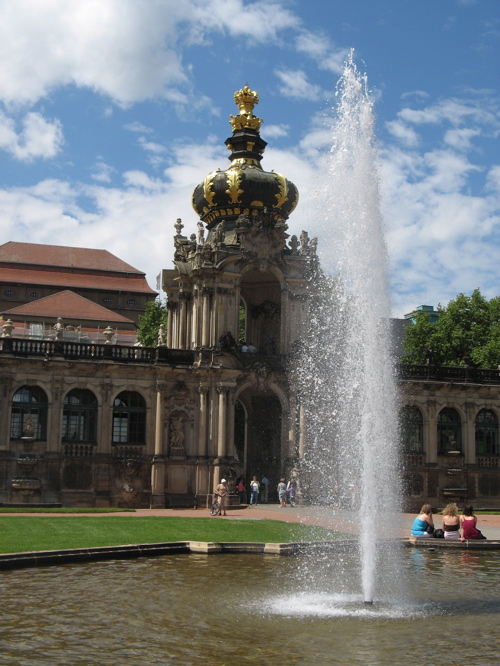
We walked next to the 19th century Semperoper (below, left, designed by
the famous German architect Gottfried Semper), but it was
closed for an opera performance. The inside is supposed to
be beautiful, but the outside was impressive enough for us!
Around the corner was this 336-foot long wall (below, center)
covered with
25,000 painted tiles that depict over 100 royal leaders of the Saxon
house of Wettin. It was interesting to see how their
costumes/armor/weapons had changed over the years! The other
streets were also interesting and it is clear that a lot of rebuilding
has gone on - and is planned - to restore the city to its former glory.
One of the most famous sights is the Frauenkirche (below, right),
recently restored after having been destroyed during the war. Its
interior is decorated with marbles and pastel paints and reminded us of
a beautiful concert hall with two levels of gallery seats.
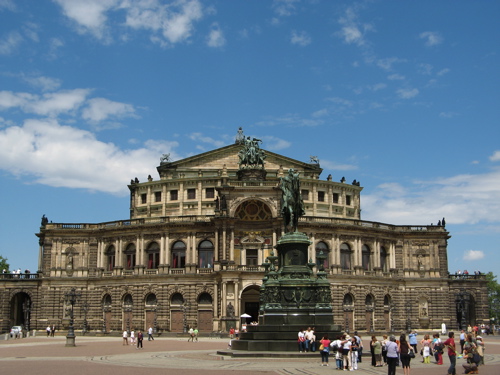
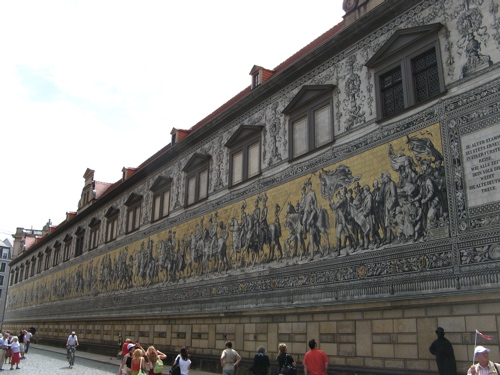
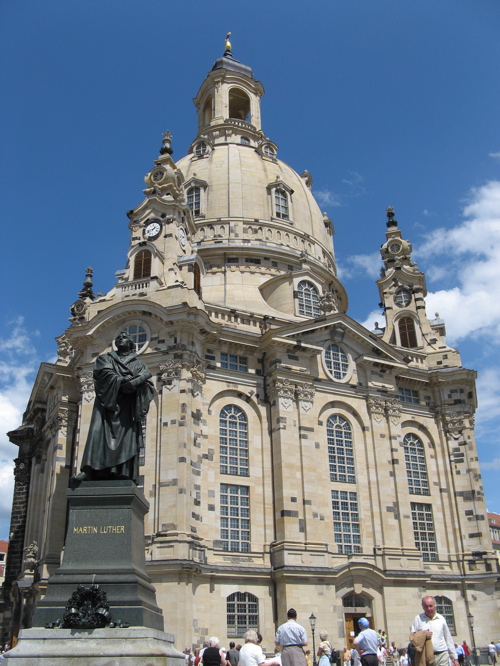
We enjoyed the views that we had of the city while walking around and
sitting by the river (there was a great tree-covered section that
afforded us some much-needed shade for a rest), so we didn't climb any of the towers available for views. We considered
walking along to the other side of the river, but decided to retrace
our steps and enjoy the beauty on the one side. We had some
surprises as we walked around, like the dome (below, left) of the
Albertium (thought of you, Cousin A) and this "Trabi safari" line of old
East German Trabant cars (below, right). We know that there is a lot
more to see and experience in Dresden, but we're glad we got
to walk around a bit at least.

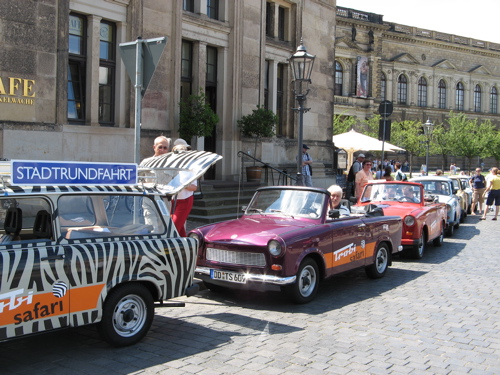
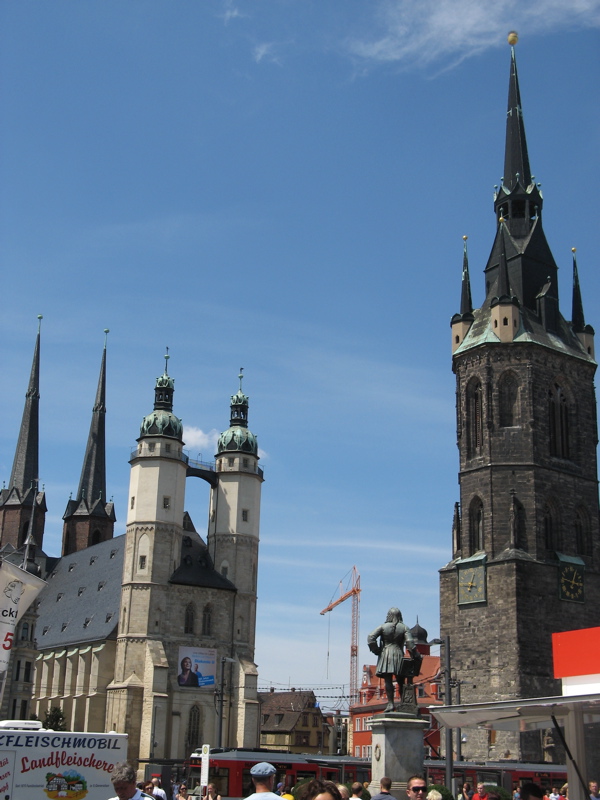
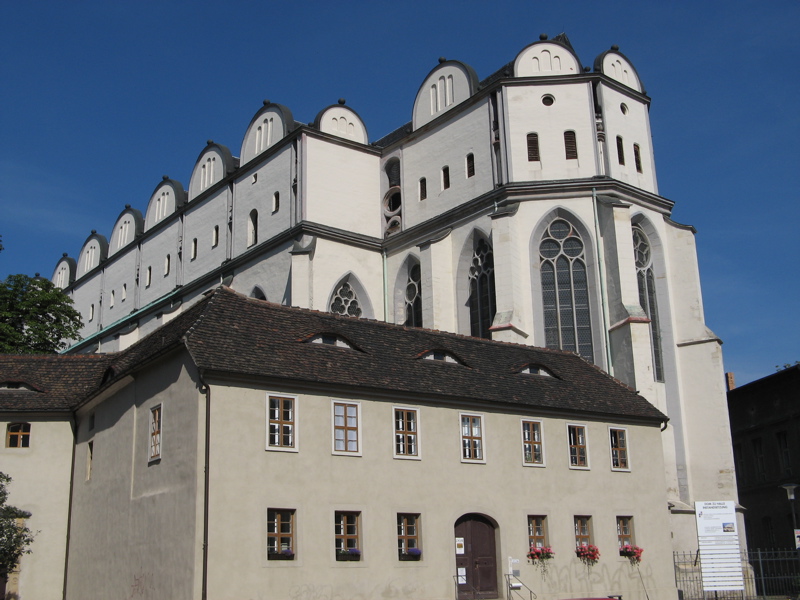
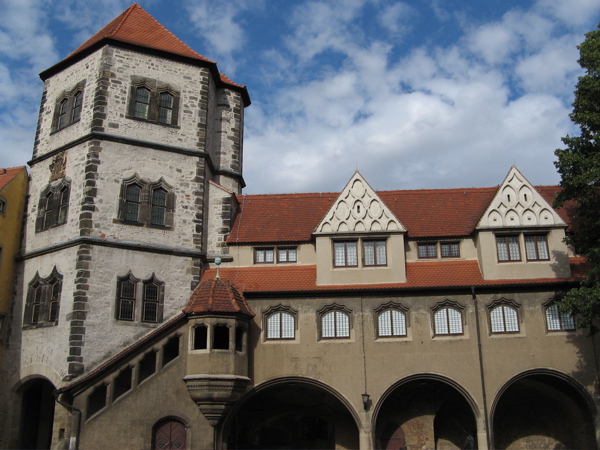
To Other June Jaunts (London, etc.)
Gerald had another morning of lectures to give, so Elyse went off exploring again. Most of the museums, etc. don't open until 10 am, so she explored the neighborhood (where she noticed the effects of East German times) and walked through a huge park that is on the edge of town. Her first stop that morning was the "Museum in the Round Corner", once the headquarters of the city's secret police (or Stasi) and now a museum describing their techniques and impact. Luckily there was a guide in English for her to read, but even without it once could sense how deeply the Stasi's power permeated society. The exhibits included costumes (e.g., wigs, fake noses, etc.) and surveillance devices (e.g., button-microphones, secret cameras, handbag-recorders) that could have been something out of a bad spy movie if one didn't realize that they were all real. There were explanations on how letters were read, copied, and often confiscated; on how even people's scents were stored (below, left) in case dogs needed to track them down later; on the cameras placed everywhere to keep track of people's movements and meetings; and on how the millions of documents were filed, stored and - when the end was imminent - attempted to be destroyed (below, right). There were exhibits of how the government got and kept its power using warnings about the presence of enemies amongst "regular" people and of those enemies' plans to undermine the fabric and values of society. There were stories of lives ruined by one negative statement and of the constant fear of a misstep that permeated society. But it was the photographs of the thousands of people with candles in front of the St. Nicholas Church and in the streets, despite the threatening presence of the police and the knowledge that people were risking everything by being there, that really "got" to Elyse. It must have taken tremendous courage to stand up - peacefully - to such power, to reject the idea of an omnipresent enemy, and to demand basic rights of protest, freedom of thought and of expression. A potent reminder of police-powers going overboard in the name of "national security".
We were lucky enough to be in Leipzig at the end of the annual Bach Music Festival. We had an extra bit of luck being there on the night of a special concert in honor of conductor Kurt Masur's (below, left) 80th birthday. [Masur had been conductor of the Gewandhaus Orchestra in Leipzig (where the concert was held) for almost 30 years, along with having been conductor for the London and New York Philharmonic Orchestras. Apparently he had also been involved in protests against the East German government. In any event, although he was born in what is now Poland, he has clearly been adopted by the city of Leipzig.] We knew we wouldn't be able to get tickets (never mind that the cheapest tickets probably cost about 200 Euros / $350), but they were broadcasting the concert on a big screen in the Augustusplatz outside the concert hall, so we got there early and found good seats right by the fountain outside the hall. We could hear the applause as famous folks entered (including special guests Kofi Annan and his wife) and see the dressed-up folks enter on the red carpet while we sat in our jeans outside. After a brief rain spell, it turned into a beautiful evening and eventually the plaza was filled with thousands of people (below, center) enjoying the music and conversations on the stage. Harald Schmidt was the moderator/MC and he was (apparently) very funny, but also clearly respected the ability of Masur and of the orchestra. The concert itself was incredible and it included a performance of Ann-Sophie Mutter (below, right) on the violin (apparently she had been mentored by Masur and they have been close friends for a long time) that was absolutely fantastic. It was actually better than being inside in some respects, especially with the close-up shots on the big screen of the musicians and Masur conducting. There was a fair bit of reminiscing (that we only partially understood) and we left about 2 1/2 hours into it to get a late dinner. The concert was still going on when we walked by on our way back to the hotel. We stopped to hear a little more music before moving on - what a special treat to end our visit.
DRESDEN
We had heard wonderful things about Dresden, especially from our friend Karin, so we decided to stop there on our way from Leipzig to Prague (we had to change trains there anyway, so we just extended our layover time). It was a beautiful day, so we left our luggage in a locker at the train station and spent the next four hours exploring the city. We felt a bit foolish doing such a quick tour, but it was infinitely better than not seeing anything of Dresden. Much of the city's splendor has been rebuilt after the severe damage it experienced during WWII and it was fun just to walk around.We first came upon the gardens at Zwinger - Baroque "pleasure grounds" created in the early 1700's. They are massive, ornate and beautiful in their overdone way. The fountains were going, the gilded towers were shimmering in the sun and there was a perfect sky to offset it all. We walked along the walls up top first and then headed into the courtyards below. As you can see, they didn't skimp on their gardens!
HALLE
The last stop on Gerald's lecture
circuit was Halle. We
were very pleasantly surprised to find it a pretty and interesting
city to visit. It is named after its main economic activity
(until the 18th century) of salt making (the word derives from the Celtic word for salt), and is best known for its
annual music festival in honor of locally-born Georg Friedrich Handel. Gerald's
colleagues said that the city has transformed itself over the last 10
years and regained some of the splendor it had before WWII and
Communist rule.
Gerald had lectures Friday afternoon and all day on Saturday. It was supposed to be very hot on Saturday, so Elyse decided to take Friday to walk around town (and save inside visits for Saturday). It was a glorious day and the central area has nice architecture and a few interesting churches that she stopped into. Below left is the main square that includes the 500-year old Market Church (with its two sets of different styled steeples), the "Red Tower" that was built as a clock tower (and to show off the wealth of the salt merchants), and a statue of Handel. The Red Tower also has the world's largest glockenspiel (according to the city's pamphlet). Whether it is the biggest or not, it sounded nice every hour! Below, center is the Cathedral (with no steeples at all!), and below, right is the Moritzburg - a 15th century palace that is now an art museum. Elyse considered stopping into the Beatles Museum (yes, a museum on the Fab Four in Halle!), but decided to skip it. Since the Botanic Gardens are located near the Physics Institute Elyse decided to end the afternoon there before meeting Gerald and his colleagues for dinner. It was a beautiful place to wander around (and grab a quick nap on a bench!) and included some interesting hot houses with strange cacti and other plants.
Gerald had lectures Friday afternoon and all day on Saturday. It was supposed to be very hot on Saturday, so Elyse decided to take Friday to walk around town (and save inside visits for Saturday). It was a glorious day and the central area has nice architecture and a few interesting churches that she stopped into. Below left is the main square that includes the 500-year old Market Church (with its two sets of different styled steeples), the "Red Tower" that was built as a clock tower (and to show off the wealth of the salt merchants), and a statue of Handel. The Red Tower also has the world's largest glockenspiel (according to the city's pamphlet). Whether it is the biggest or not, it sounded nice every hour! Below, center is the Cathedral (with no steeples at all!), and below, right is the Moritzburg - a 15th century palace that is now an art museum. Elyse considered stopping into the Beatles Museum (yes, a museum on the Fab Four in Halle!), but decided to skip it. Since the Botanic Gardens are located near the Physics Institute Elyse decided to end the afternoon there before meeting Gerald and his colleagues for dinner. It was a beautiful place to wander around (and grab a quick nap on a bench!) and included some interesting hot houses with strange cacti and other plants.
Saturday was a full day of museum
visiting (for Elyse; for Gerald, it was a full day of lectures!).
Elyse started at the Neue Residenz (because it opened earliest
and was right near the Physics institute) where there was an natural
history exhibit. The exhibits contained fossils and skeletons
from the local area, but all the explanations were in German. There were some very cool
sets of teeth from crocodiles and tapirs, etc. and this funky turtle
skeleton, so she had fun despite the language barrier
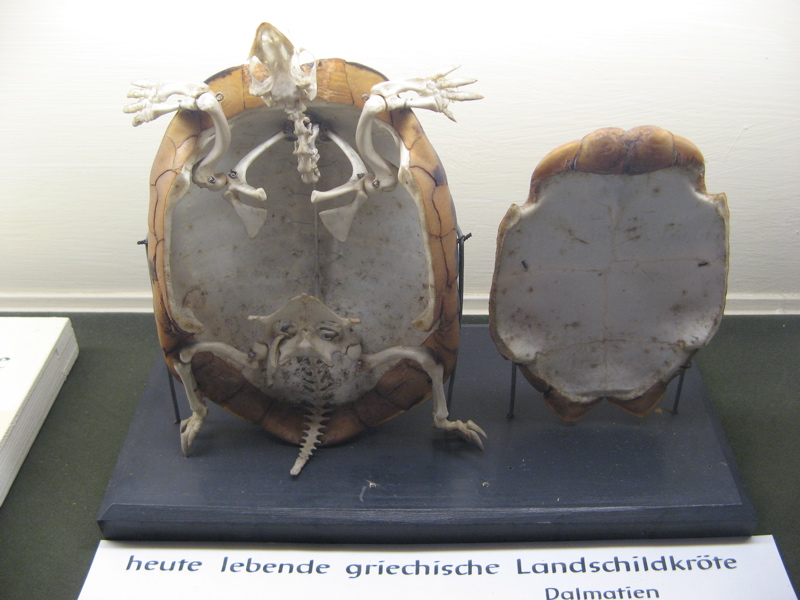

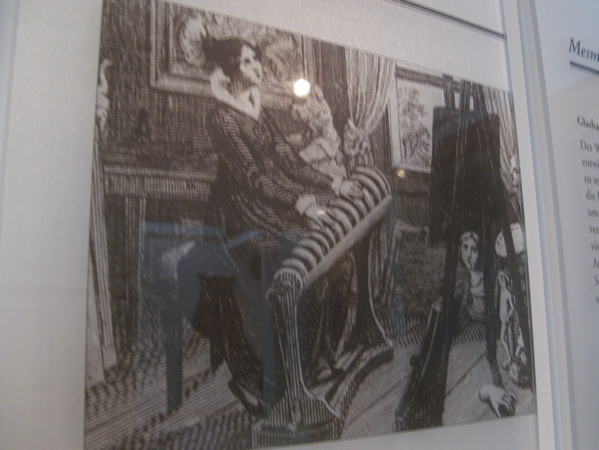
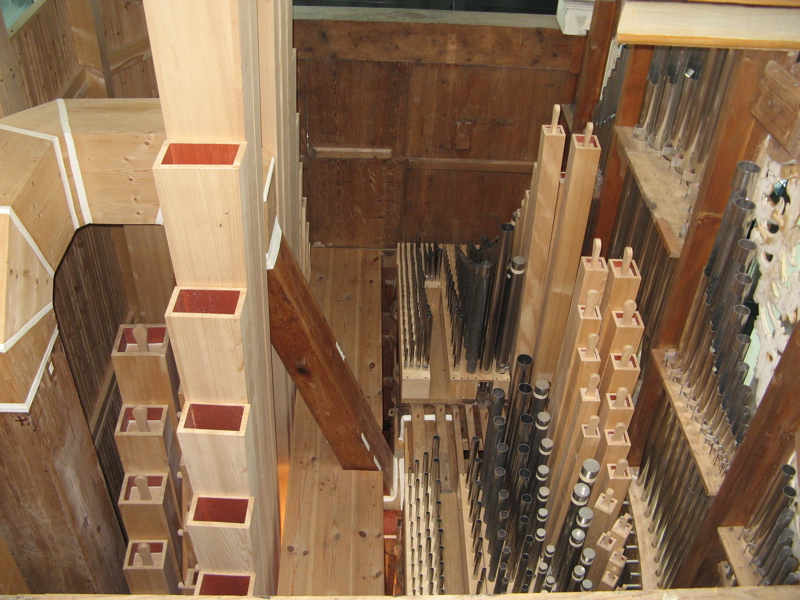
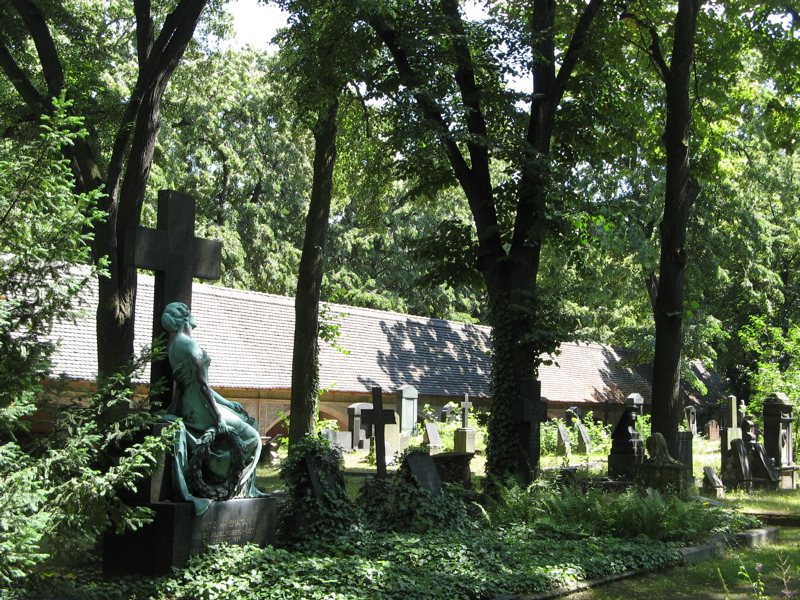
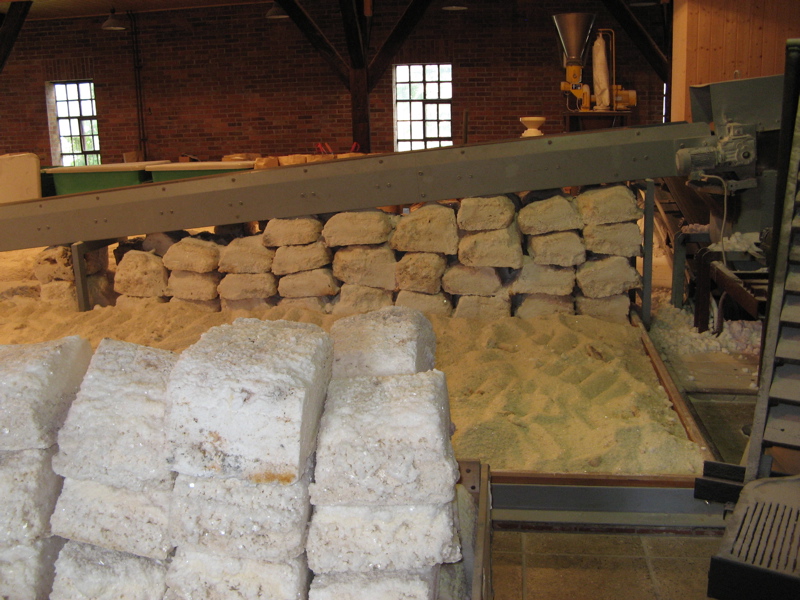
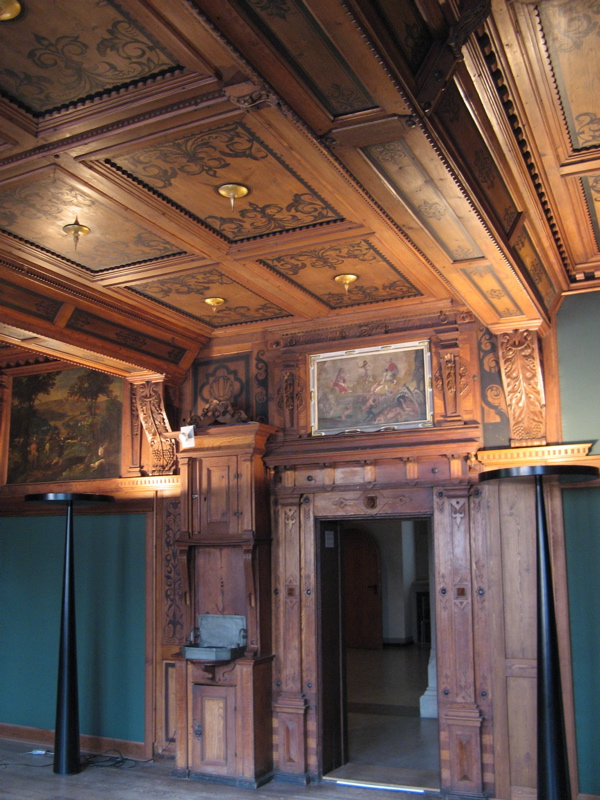
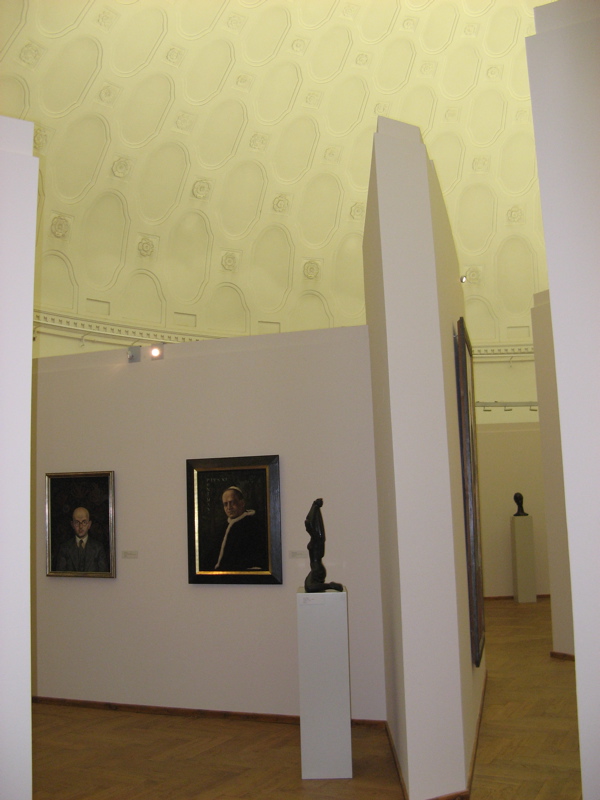
To Prague PageHer next stop was the highlight of the
day - the Handel-Haus.
Georg Friedrich Händel was born in Halle and lived there
through his school years. He moved to Hamburg for his music
courses and then moved to Hamburg and to Italy before settling in
London until he died in 1759. The museum is located in his
birth-house, but the
building itself has been restructured over the years, so it wasn't set
up as his house. The exhibit included information (including
English translations), documents (including music scores in Handel's
own
handwriting) and artifacts from each stage in his life. In many
of the rooms there were also instruments from this period, including
some pictured below (the portrait in the left photo
is the local boy himself). The picture on the right was from the
phenomenal musical instrument collection that is also housed in the
museum. The collection is on two floors and the second floor
allows visitors to look inside an organ from above (below, right).
Very interesting. The rest of the collection was
fascinating, with variety of keyboards, wind, string and brass
instruments that were often beautifully decorated. There is also
a glass harmonica that was designed by Franz Anton Mesmer (as in mesmerize since he first used hypnotism). The picture below in the middle demonstrates how it would be played. One can go on
a tour that allows visitors to play many of the instruments, too!
Now that would be fun.
There was a computer and headset that Elyse used to listen to a
variety of pieces by Handel - including arias from some of the operas
he composed (often in just a matter of weeks!).
Elyse finally dragged herself out of the
museum (without visiting the wing on other local/German
musicians) as her stomach was demanding something for lunch and her
brain was turning into a bit of a musical mush. She had read
about a 500-year old cemetery on the other side of town that was
supposed to be beautiful, so she had planned to get a sandwich and eat
lunch in there. Might sound morbid to some of you (except
for some U. of Rochester grads who regularly enjoyed the peace
and beauty of Mt. Hope Cemetery), but the tree-shaded quiet sounded
very appealing in the middle of this very hot day.
The cemetery is, in fact, beautiful - lined with arched niches
and filled with trees and some elaborate headstones. Elyse had
done a walk-around and was about to sit down and eat when others came
in to walk around. She wasn't sure how comfortable others would
feel about her eating there, so she headed out to a nearby park and founded a shaded bench to rest her legs and eat.
The next stop on the Halle tour was the
Salt Works, where salt was panned from wells and evaporated over fires,
providing a major economic benefit for the city for many years. There
is archaeological evidence (briquette molds) that salt processing has
been going on in the area for more than a thousand years, but this
particular site was active from 1722 until 1964. Apparently the
town's workers produced 10 tons
of salt per year in the 13th century and had doubled that amount by the
16th. The exhibit also documented the activities of the workers,
including their annual festivals. And there was a fantastic
exhibit of aerial photographs of salt "fields" around the world. Really beautiful.
The last museum stop was the art museum
at the Moritzburg Castle. The building itself was beautiful
(below, left), but there was an Avant Garde exhibition that Elyse
didn't really like very much. The permanent collection, located
in the large domed room pictured below, is small, but included
some beautiful sculptures and paintings.
After a bit more meandering around town,
it was time to meet Gerald. We had some time before our train, so
we stopped into the Market Church and were able to sneak a peak at the
death mask of Martin Luther (he preached here a few times;
the mask was made when they stopped here on the way to Wittenberg for
burial). Someone was playing the old organ, so we got a beautiful
concert as we explored. We also took a quick tour around the musical
instrument
exhibit at the Handel Haus. It ended up we were on the same
train(s) as the other
lecturer from Heidelberg, so we had some friendly, interesting company
for the 5 hours or so that it took to get home. It was a full and
satisfying few days for both of us and we were glad that Gerald had
agreed to participate in this lecture series.
To Other June Jaunts (London, etc.)